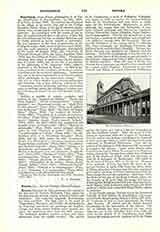

Nourrisson, JEAN—FELIX, philosopher, b. at Thiers, Department of Puy-de-Dome, July 18, 1825; d. at Paris, June 13, 1899. He received his education in the college of his native city and in the College Stanislas (Paris), where, at the age of nineteen, immediately after completing his studies, he was appointed professor. In accordance with the wishes of his father, he applied himself first to the study of law, but his own inclinations led him in another direction, and he finally decided to devote himself to philosophy. He was appointed to the chair of philosophy in the College Stanislas (1849), received the Doctorate (1852), and was made professor of philosophy successively in the Lycee de Rennes (1854), the University of Clermont-Ferrand (1855), the Lycee Napoleon, Paris (1858) and the College de France (1874). Nourrisson obtained three prizes in competitions on the philosophy of Leibniz (1860), and on the role of psychology in the philosophy of St. Augustine (1864), subjects proposed by the Institut de France. In 1870 he became a member of the Academie des Sciences morales et politiques in the section of philosophy. Nourrisson was one of the best representatives of French spiritualistic philosophy in the nineteenth century. Not only was he a deep thinker, a penetrating philosopher and historian, but a firm believer, convinced that “conscience remains hesitating, and that convictions come to nothing, unless the teachings of religion complete the data of reason” (letter to de Barante, December 5, 1856).
Besides a number of reports, memoirs, and articles in the “Journal des Debats”, “Revue des Deux Mondes”, “Revue Contemporaine”, “Correspondent”, etc., Nourrisson’s works are: “Quid Plato de ideis senserit” (Paris, 1852); “Essai sur la philosophie de Bossuet” (Paris, 1852); “Les Peres de l’Eglise latine” (Paris, 1856); “Le cardinal de Berulle” (Paris, 1856); “Exposition de la theorie platonicienne des idees” (Paris, 1858); “Tableau des progres de la pensee humaine depuis Thales jusqu’a Leibniz” (Paris, 1858), the third edition was augmented and brought down to Hegel’s time (1867); “Histoire et philosophie” (Paris, 1860); second enlarged edition under the title “Portraits et etudes” (Paris, 1863); “La philosophie de Leibniz” (Paris, 1860); “Le dixhuitieme siecle et la Revolution francaise” (Paris, 1863), 2nd ed., 1873, under the title “L’ancienne France et la Revolution”; “La nature humaine: essais de psychologie appliquee” (Paris, 1865); “La philosophie de Saint-Augustin” (Paris, 1865); “Spinoza et le naturalisme contemporain” (Paris, 1866); “De la liberte et du hasard, essai sur Alexandre d’Aphrodisias” (Paris, 1870); “Machiavel” (Paris, 1875); “Trois revolutionnaires: Turgot, Necker, Bailly” (Paris, 1885); “Pascal, physicien et philosophe” (Paris, 1885); “Philosophes de la nature: Bacon, Bayle, Toland, Buffon” (Paris, 1887); “Defense de Pascal” (Paris, 1888); “Voltaire et le voltairianisme” (Paris, s. d.); “Rousseau et le rousseauisme” (Paris, 1904), a posthumous work edited by Paul Nourrisson.
C. A. DUBRAY.

